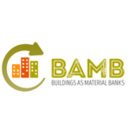Resource productivity
Definition
Resource productivity in the construction sector should be interpreted as the measure of the annual quantity of extracted virgin materials, in relation to the (economic) value created from this quantity.
Maximising resource productivity is one of the objectives when setting up a circular economy and using buildings as Material(s) Banks.
After all, it is expected that relatively more value will be created during the production of goods and the delivery of services if waste is avoided and materials are reused.
Guidelines
The proposed definition is adopted from the conventional definition of resource productivity by the European Commission, wherein the total Domestic Material Consumption is replaced by the quantity of extracted virgin materials. Consequently, this measure will increase if more materials are reused. This interpretation requires however further investigation.
Moreover, an increase in resource productivity, might indicate that a decoupling between the extraction of virgin materials and economic development takes place. This measure could change many mind-sets and make clear that well-being is not related to the level of material extraction and that lowering raw material use rates should not result in reduced economic development.
Further, note that ‘productivity’ is a measure of an economic activity, but not the activity itself.
References
Debacker W. and Manshoven S. (2016) Synthesis of the state-of-the-art BAMB report: Key barriers and opportunities for Materials Passports and Reversible Building Design in the current system. VITO.
Ellen MacArthur Foundation (2012) Towards the Circular Economy, an economic and business rationale for an accelerated transition. Cowes: Ellen MacArthur Foundation.
Eurostat (2016) Resource productivity – Statistics Explained. Retrieved March 2017, from http://ec.europa.eu/eurostat/statistics-explained/index.php/Glossary:Resource_productivity
Urban mining: recovering materials or assemblies of materials from the building stock instead of using virgin materials.
Rare earth elements: chemical elements found in the earth’s crust that are vital to many modern technologies but are difficult to find in quantities enabling their economic development.
--BAMB - Buildings As Material Banks 08:16, 15 Aug 2018 (BST)
Featured articles and news
UCEM becomes the University of the Built Environment
Major milestone in its 106-year history, follows recent merger with London School of Architecture (LSE).
Professional practical experience for Architects in training
The long process to transform the nature of education and professional practical experience in the Architecture profession following recent reports.
A people-first approach to retrofit
Moving away from the destructive paradigm of fabric-first.
International Electrician Day, 10 June 2025
Celebrating the role of electrical engineers from André-Marie Amperè, today and for the future.
New guide for clients launched at Houses of Parliament
'There has never been a more important time for clients to step up and ...ask the right questions'
The impact of recycled slate tiles
Innovation across the decades.
EPC changes for existing buildings
Changes and their context as the new RdSAP methodology comes into use from 15 June.
Skills England publishes Sector skills needs assessments
Priority areas relating to the built environment highlighted and described in brief.
BSRIA HVAC Market Watch - May 2025 Edition
Heat Pump Market Outlook: Policy, Performance & Refrigerant Trends for 2025–2028.
Committing to EDI in construction with CIOB
Built Environment professional bodies deepen commitment to EDI with two new signatories: CIAT and CICES.
Government Grenfell progress report at a glance
Line by line recomendation overview, with links to more details.
An engaging and lively review of his professional life.
Sustainable heating for listed buildings
A problem that needs to be approached intelligently.
50th Golden anniversary ECA Edmundson apprentice award
Deadline for entries has been extended to Friday 27 June, so don't miss out!
CIAT at the London Festival of Architecture
Designing for Everyone: Breaking Barriers in Inclusive Architecture.
Mixed reactions to apprenticeship and skills reform 2025
A 'welcome shift' for some and a 'backwards step' for others.























